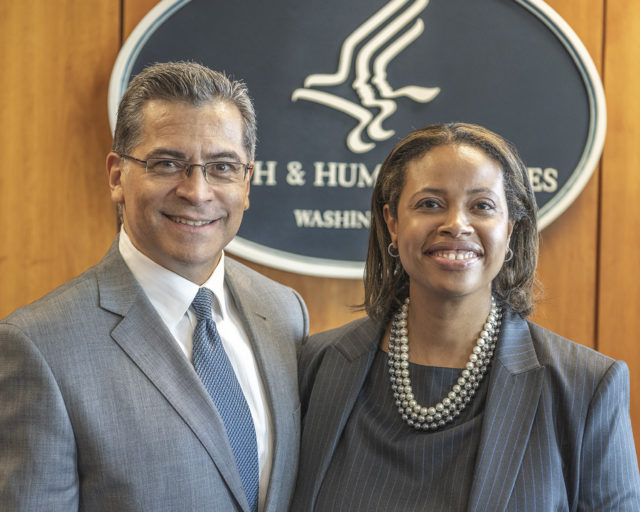
HHS Secretary Xavier Becerra and Chiquita Brooks LaSure at her swearing in ceremony on May 27.
The U.S. Department of Health and Human Services (HHS) and Treasury Department issued a sweeping final rule on September 17th that seeks to make marketplace coverage more equitable while reversing Trump-era regulatory changes under the Affordable Care Act (ACA). On Wednesday, Centers for Medicare and Medicaid (CMS) Administrator Chiquita Brooks-LaSure discussed the need for these and other Biden-promoted health provisions, placing them in the context of widening health inequities during Covid-19.
“No one should be left out, left behind, or left on the sidelines when it comes to healthcare,” Brooks-LaSure said. “As the first African-American woman to lead CMS, I want to make sure that our programs are operating to reduce the health disparities that underlie our healthcare system, which were particularly illuminated in the Covid pandemic.”
The rule in a nutshell
The rule extends the 2022 open enrollment period for Healthcare.gov by 30 days, to January 15. It also raises the federally-run marketplace user fee from the 2.25% of premiums approved under the Trump administration in January to 2.75% and the state-run exchanges from 1.75% to 2.25%, to cover increased outreach costs.
Most notably, the rule introduces a new Special Enrollment Period (SEP) for low-income uninsured people, including lawfully-present immigrants, each month. Inspired by the wild success of the American Rescue Plan Act‘s SEP this year, this provision seeks to ensure that traditionally underinsured groups don’t miss their chance to get covered as soon as they learn about the marketplace’s benefits.
More time to weigh marketplace options
HHS justified its decision to extend the deadline for joining the marketplace by explaining that many patients who are auto-enrolled need that extra time to consider whether the level of insurance they are purchasing is correct for their needs and to change premiums if it is not. Many state-run exchanges already have enrollment periods ending January 15. Consumer advocate commenters were supportive of this aspect of the proposed rule.
Marketplace insurers, on the other hand, had argued the later deadline would lead to “adverse selection,” wherein healthier enrollees delay signing up for coverage until the last minute, while sicker people would enroll earlier, thus increasing costs and premiums. However, HHS determined that the overall benefits outweighed this risk.
Expanding awareness
The Centers for Medicare and Medicaid Services (CMS) expects to use the $200 million in fees generated through this increase to make ACA more equitable by increasing awareness and access to underserved populations.
This includes a fourfold expansion to 1,500 healthcare navigators in the 2022 coverage year that it paid for through an $80 million grant issued earlier this year. CMS will also re-launch the “Champions for Coverage” program, where community organizations educate consumers about Healthcare.gov, Medicaid and the Children’s Health Insurance Program (CHIP).
The agency further plans to use the fees to train these navigators and community agencies in guiding low-income, non-native English speaking and other underserved enrollees through more sticky post-enrollment issues. Community educators will become experts in how to appeal a marketplace rejection and reconciling premium tax credits, among other topics, according to CMS.
In a fact sheet, CMS noted the proposed rates were still lower than those currently being paid in the 2021 benefit year, which were 3% for the federal marketplace and 2.5% for state-based exchanges. Stakeholders, including marketplace insurers, were generally supportive of this rate change.
Allowing low-income uninsured to enroll year-round
The rule introduces a new Special Enrollment Period (SEP) that will open the marketplace on a monthly basis to low-income consumers who are eligible for advance premium tax credits and earn up to 150% of the federal poverty level (FPL), including lawfully-present immigrants.
This will provide an affordable option for millions of people expected to lose Medicaid coverage at the end of the declared public health emergency, according to CMS Administrator Chiquita Brooks-LaSure.
“We are poised and ready to help support states on eligibility and enrollment actions after the public emergency ends,” Brooks-LaSure said in a presentation to state marketplace leaders on Wednesday. “This unwinding will take a strong partnership between the states and CMS to ensure consumers are seamlessly covered for necessary services.”
While the new policy will be permanent, it will only be active when its target population qualifies for the maximum advance premium tax credit, meaning when Congress sets taxpayers’ premium contribution to zero percent, as it has under the American Rescue Plan Act (ARPA).
Under ARPA, health insurance consumers making up to 150% of FPL qualify for either free or extremely affordable premiums on benchmark Silver plans, as well as cost-sharing reductions that render their coverage platinum-equivalent. Though ARPA’s enhanced subsidies are temporary, Congress is currently debating whether to make them permanent, which would extend the duration of this new income-based SEP. Brooks-LaSure called this extension of enhanced subsidies “critically important.”
“We’ve gotten to see what a difference enhanced subsidies and enhanced outreach efforts make at the beginning of our [latest] Special Enrollment Period,” Brooks-LaSure said. “We saw an increase right around the time the administration opened up the SEP: we put $10 million on the table to navigators and we saw a bump up, which was wonderful to see; and then the ARPA subsidies took effect and we saw quite a bump up — when we see that, what we are seeing is that when we make coverage affordable, what a difference it makes in terms of enrollment.”
Eradicating the state private opt-out
While it made participation in the low-income SEP optional to state-based exchanges (SBEs) and allowed states to set their own open enrollment deadlines, as long as they fall on or after December 15, 2021, the rule eradicated the option for private, state-level Exchange Direct Enrollment (Exchange DE) programs.
The Exchange DE program was inspired by Georgia’s Section 1332 waiver, which allowed that state to opt out of Healthcare.gov and instead use its own network of private insurers. Consumer and state advocates had expressed concern such private exchanges would confuse consumers and increase the risk of abuse by fraudulent actors.
HHS went further, saying that supporting this program was antithetical to the Biden Administration’s priorities and it was going to invest resources in doing the “unfinished work of the ACA,” as Brooks-LaSure puts it.
“It was never intended for the lowest-income among us not to have coverage,” Brooks-LaSure said, “and we are very happy to work with states that want to expand — I hope states will take up the Medicaid expansion… but if for whatever reason the states are not in that position, we need a federal solution and I think that Congress is seeing the importance of covering everyone, whether that’s through the marketplace, whether that’s through a federal Medicaid program, the important issue I would say is making sure people have coverage.”
Getting ACA back on track
This was HHS’ first rule addressing the federal and state healthcare marketplaces, which Jessica Altman, Commissioner, Pennsylvania Insurance Department (PID) jokingly refers to as the “third M” in CMS.
She joined her fellow state marketplace leaders in celebrating the rule’s proposals.
“PID is pleased with the steps that HHS has taken through this rule, which returns the individual health insurance marketplace to the trajectory it was on under the Obama Administration and builds on the opportunities Congress provided under the American Rescue Plan Act,” Commissioner Altman said in an email.
While Pennsylvania is not accountable for many of the rule’s requirements as a state that manages its own exchange, Commissioner Altman said she looked forward to implementing the SEP for low-income people as part of Pennsylvania’s state exchange, Pennie.
California’s exchange is already a step ahead, opening up an SEP this month to protect enrollees set to lose their federal health subsidies. Its director applauds the rule’s consumer-centric expanded SEP and other enrollment-boosing provisions.
“The final rule demonstrates the Biden Administration’s commitment to both reverse actions taken by the prior administration to undercut the ACA and to implement new policies that can promote more enrollment,” Peter Lee, executive director of Covered California, said in an email. “We’re seeing this administration lean in, using all the tools they have to expand coverage in meaningful ways.”








